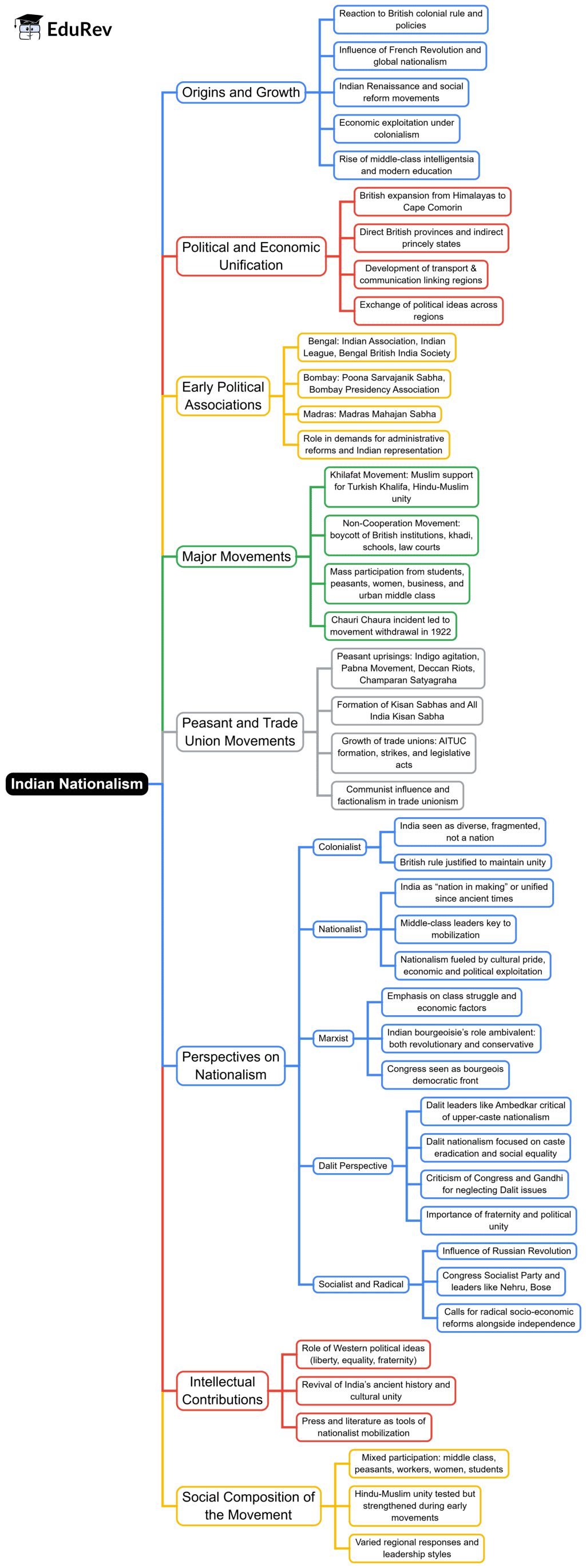UPSC Exam > UPSC Notes > PSIR Optional for UPSC > Mind Map: Indian Nationalism
Mind Map: Indian Nationalism | PSIR Optional for UPSC PDF Download

The document Mind Map: Indian Nationalism | PSIR Optional for UPSC is a part of the UPSC Course PSIR Optional for UPSC.
All you need of UPSC at this link: UPSC
|
173 videos|574 docs|148 tests
|
FAQs on Mind Map: Indian Nationalism - PSIR Optional for UPSC
| 1. What were the main factors that contributed to the rise of Indian nationalism in the late 19th and early 20th centuries? |  |
Ans. The rise of Indian nationalism in the late 19th and early 20th centuries was influenced by several factors, including the impact of British colonial policies that led to economic exploitation, social reforms, and political awakening among the Indian populace. The introduction of Western education fostered a new class of educated Indians who began to question colonial rule. Events such as the Partition of Bengal in 1905 also galvanized nationalist sentiments. Additionally, the influence of various socio-religious reform movements and the establishment of organizations like the Indian National Congress played a pivotal role in uniting diverse groups against colonial oppression.
| 2. How did the Indian National Congress evolve from its formation to the independence movement? |  |
Ans. The Indian National Congress (INC) was founded in 1885 as a platform for political dialogue among educated Indians and the British government. Initially, it aimed for moderate reforms and sought representation for Indians in governance. However, over time, especially post-1905, it transformed into a mass movement advocating for complete independence. Key figures such as Gandhi, Nehru, and Bose shifted the INC's strategies towards mass mobilization, civil disobedience, and non-violent resistance. The INC's demands evolved from constitutional reforms to full sovereignty, culminating in the demand for independence during the Quit India Movement in 1942.
| 3. What role did leaders like Mahatma Gandhi and Jawaharlal Nehru play in shaping Indian nationalism? |  |
Ans. Mahatma Gandhi and Jawaharlal Nehru were instrumental in shaping Indian nationalism. Gandhi introduced the philosophy of non-violent resistance (Satyagraha) and mobilized millions through mass movements such as the Salt March in 1930 and the Quit India Movement in 1942. His emphasis on self-reliance (Swadeshi) and rural empowerment resonated with the masses. Nehru, on the other hand, provided a vision of a modern, secular, and democratic India. As a key leader of the INC, his ideologies of socialism and his focus on industrialization played a crucial role in uniting diverse factions within the nationalist movement.
| 4. What were the significant events that marked the Indian independence struggle? |  |
Ans. Several significant events marked the Indian independence struggle, including the First War of Independence in 1857, which was an early expression of anti-colonial sentiment. The formation of the Indian National Congress in 1885 laid the groundwork for organized political resistance. The partition of Bengal in 1905 sparked widespread agitation, while the Jallianwala Bagh massacre in 1919 intensified anti-British sentiments. The Civil Disobedience Movement in the 1930s and the Quit India Movement in 1942 were pivotal in mobilizing public support for independence, leading to negotiations with the British and ultimately the attainment of independence in 1947.
| 5. How did social and cultural movements contribute to Indian nationalism? |  |
Ans. Social and cultural movements played a vital role in the rise of Indian nationalism by fostering a sense of unity and identity among diverse communities. Reform movements such as the Arya Samaj and the Aligarh Movement sought to revive and reform Hindu and Muslim identities, respectively, while addressing social issues like caste discrimination and women's rights. Literature, music, and art became tools of resistance, with figures like Rabindranath Tagore promoting national consciousness through their works. The promotion of indigenous languages and cultural heritage helped instill pride among Indians, creating a collective national identity that transcended regional and religious divides.
Related Searches
















